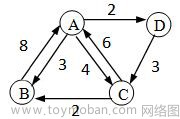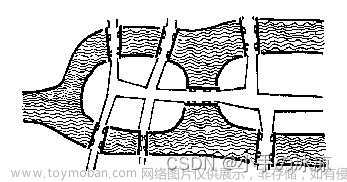目录
引入:leetcode695.岛屿的最大面积
分析与转换
一维二维转换
四联通
完整代码解答:
1)显示的创建图解决问题的代码
2)不显示的创建图解决此问题的代码
floodfill算法
定义
引入:leetcode695.岛屿的最大面积

分析与转换:
在题目中0是海水,1是陆地。在我们自己设定的图中假设蓝色是海水,红色是陆地。且每一个小格子都是一个顶点,若某个红色顶点上下左右方向有另外的红色顶点与它相邻,则在它俩中间连接一条边证明其一同构成了一个岛屿,也就是同属于一个连通分量。这样,我们就把这道题转换成了一个图论的问题。我们要求的问题也就转换成了找出包含顶点最多的连通分量,顶点个数也就是面积的最大值。

一维二维转换:
我们还可以通过数学公式将二维和一维相互转换。注意一维是从0开始计数, 二维是从1开始计数。

四联通:
我们需要搜索一个红色顶点的上下左右的顶点是否还是陆地,那么如何搜索呢?这就涉及到了四联通的概念。我们可以设立一个二维数组,里面的四个元素代表了相较于本顶点而言,它的行列坐标的位移,也就是表示它的上下左右各移动一个单位的四个坐标。值得注意的是,我们现在的坐标系不是我们熟知的数学坐标系,而是我们计算机一般使用的屏幕坐标系,我们可以理解成二维数组索引所在的坐标系。

d循环四次代表上下左右四个方向。

文章来源:https://www.toymoban.com/news/detail-740812.html
完整代码解答:
1)显示的创建图解决问题的代码
import java.util.HashSet;
class Solution {
private int[][] dirs = {{-1, 0}, {0, 1}, {1, 0}, {0, -1}};
private int R, C;//行数列数
private int[][] grid;
private HashSet<Integer>[] G;//图的邻接表的表示
private boolean[] visited;
public int maxAreaOfIsland(int[][] grid){
if(grid == null) return 0;
R = grid.length;
if(R == 0) return 0;
C = grid[0].length;
if(C == 0) return 0;
this.grid = grid;
G = constructGraph();//进行建图操作
int res = 0;
visited = new boolean[G.length];
for(int v = 0; v < G.length; v ++){
int x = v / C, y = v % C;
if(grid[x][y] == 1 && !visited[v])//如果v没被遍历过就是证明找到了一个新的岛屿,即一个新的连通分量。
res = Math.max(res, dfs(v));
}
return res;
}
private int dfs(int v){
visited[v] = true;
int res = 1;//1是这是深度优先遍历v这个顶点
for(int w: G[v])
if(!visited[w])
res += dfs(w);
return res;
}
private HashSet<Integer>[] constructGraph(){
HashSet<Integer>[] g = new HashSet[R * C];//开辟空间
for(int i = 0; i < g.length; i ++)
g[i] = new HashSet<>();
for(int v = 0; v < g.length; v ++){
int x = v / C, y = v % C;//转换成二维坐标
if(grid[x][y] == 1){//只有它本身是陆地才去判断它四周是否有其他陆地与之相连
for(int d = 0; d < 4; d ++){
int nextx = x + dirs[d][0];
int nexty = y + dirs[d][1];
if(inArea(nextx, nexty) && grid[nextx][nexty] == 1) {//判断nextx和nexty是否合法(是否在网格范围中)
int next = nextx * C + nexty;//转为一维索引
g[v].add(next);//添加一条边
g[next].add(v);
}
}
}
}
return g;
}
private boolean inArea(int x, int y){
return x >= 0 && x < R && y >= 0 && y < C;
}
public static void main(String[] args){
int[][] grid = {{0, 1}};
System.out.println((new Solution()).maxAreaOfIsland(grid));
}
}2)不显示的创建图解决此问题的代码
class Solution {
private int[][] dirs = {{-1, 0}, {0, 1}, {1, 0}, {0, -1}};
private int R, C;
private int[][] grid;
private boolean[][] visited;
public int maxAreaOfIsland(int[][] grid){
if(grid == null) return 0;
R = grid.length;
if(R == 0) return 0;
C = grid[0].length;
if(C == 0) return 0;
this.grid = grid;
visited = new boolean[R][C];
int res = 0;
for(int i = 0; i < R; i ++)//二重循环遍历每一个顶点
for(int j = 0; j < C; j ++)
if(grid[i][j] == 1 && !visited[i][j])
res = Math.max(res, dfs(i, j));
return res;
}
private int dfs(int x, int y){
visited[x][y] = true;
int res = 1;
for(int d = 0; d < 4; d ++){
int nextx = x + dirs[d][0], nexty = y + dirs[d][1];
if(inArea(nextx, nexty) && grid[nextx][nexty] == 1 && !visited[nextx][nexty])
res += dfs(nextx, nexty);
}
return res;
}
private boolean inArea(int x, int y){
return x >= 0 && x < R && y >= 0 && y < C;
}
}floodfill算法
定义:
floodfill算法是一种图像处理算法,用于填充连通区域。该算法从一个起始点开始,将所有与该点相邻且颜色相同的像素点都标记为同一区域,并继续递归处理该区域的相邻像素点,直到所有相邻像素点都被标记为该区域。该算法通常用于图像处理、计算机图形学等领域中的填充操作,例如对图像中的某个区域进行颜色填充、图形的边界检测等。文章来源地址https://www.toymoban.com/news/detail-740812.html
到了这里,关于图论问题建模和floodfill算法的文章就介绍完了。如果您还想了解更多内容,请在右上角搜索TOY模板网以前的文章或继续浏览下面的相关文章,希望大家以后多多支持TOY模板网!













